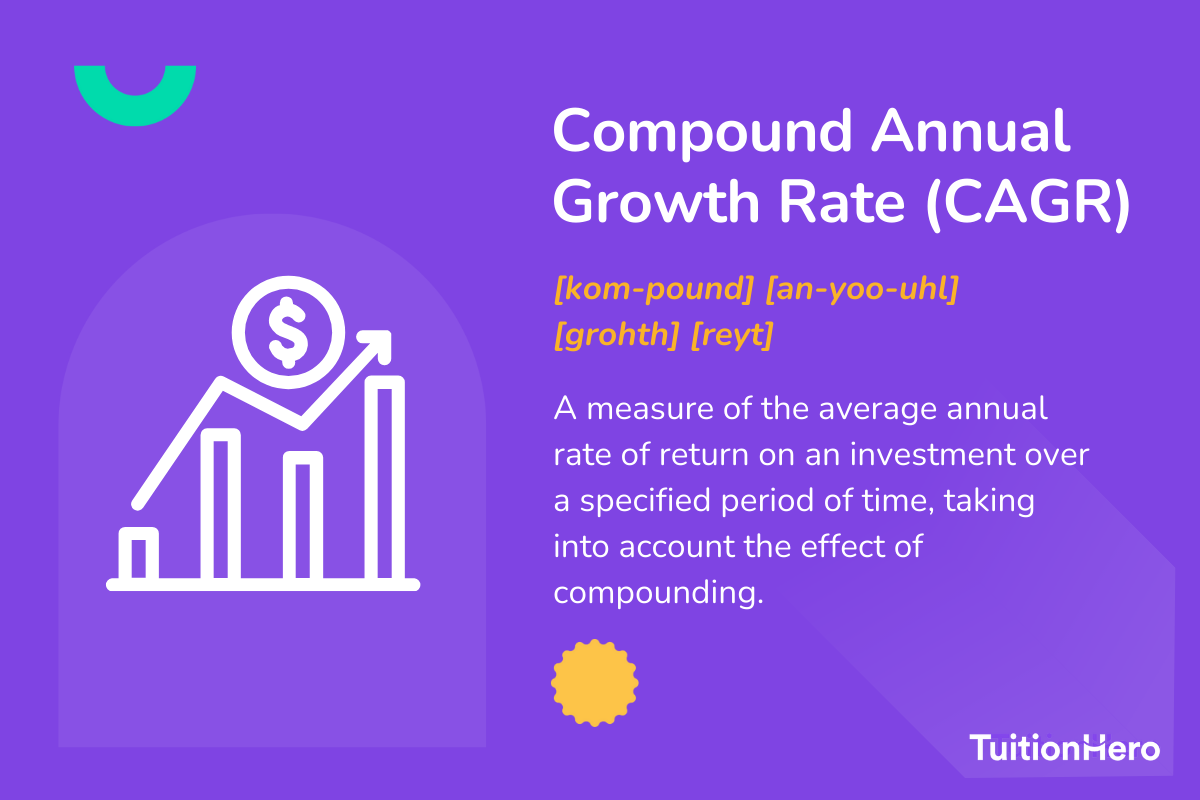Advertiser Disclosure
Last update: November 17, 2024
6 minutes read
What is the Compound Annual Growth Rate? (CAGR Explained)
Ever heard the term compound annual growth rate? Learn all about CAGR for smarter investments. Dive into its advantages, pitfalls, and its effect on student finances.

By Brian Flaherty, B.A. Economics
Edited by Rachel Lauren, B.A. in Business and Political Economy
Learn more about our editorial standards



By Brian Flaherty, B.A. Economics
Edited by Rachel Lauren, B.A. in Business and Political Economy
Learn more about our editorial standards
Ever had that feeling when you're staring at your investment portfolio, wondering if you're truly seeing the growth you expected? Or maybe you're trying to compare two different investments, and the numbers seem confusing? You're not alone.
Making the right financial decisions is critical, especially in the world of student loans. So, here's the golden question: how do you measure the genuine, consistent growth of an investment over multiple years, especially when that ride has its ups and downs? Good news! There's a neat term for that - CAGR. Let's dive in and learn more about it!

Key takeaways
- CAGR offers a "smoothed out" view of investment growth over time
- It's different from the Average Annual Return, which can sometimes be misleading
- The Sharpe Ratio provides a more realistic view by accounting for investment volatility
What is the Compound Annual Growth Rate (CAGR)?
The CAGR is a mathematical formula offering a "smoothed" rate of return, letting you in on what an investment yields on an annually compounded basis. In essence, it's the go-to number that tells you what you'll have in your pocket at the end of the investment period.

So, how does CAGR work?
Compound annual growth is not the same as credit card interest. It's a little different. Let's break it down.
Say you put $1,000 into an investment in 2016, and by year's end, it blossomed to $3,000. Insane, right? But hold on; the market can be a roller-coaster.
The next year, it plummets, and you lose half of that, leaving you with $1,500. Now, if you tried to average this out, you'd get it all wrong. Instead, you use CAGR, which tells you the real story by considering the entire journey of your investment.
To get to the heart of it:
- Start with your total return (50% in this case - going from $1000 to $1500).
- Take the square root of 1 plus 50% (because it's a two-year investment). For a 3-year investment, you’d take the cube root, then the fourth root, and so on.
- Ta-da! Subtract 1 from your answer, and you've got a CAGR of 22.5%.
Sounds simple, but it's a big help in understanding investments. I use the CAGR all the time to help me understand my portfolio and make reliable investment decisions.
If we had calculated the average annual return, we would get 75% (averaging together 200% the first year, and -50% the second year). Not a great way to measure the true return.
Why is CAGR a solid choice for evaluating investments?
Beyond just being a neat formula, CAGR serves up some serious perks for investors.
- Comparison power: CAGR lets you weigh how many investments performed over time. So, if you're deciding between stock A and stock B, CAGR has got your back.
- Fixes average return limitations: Remember that average return we talked about earlier? Yeah, that can be misleading. CAGR gives you a clearer, more accurate picture.
- Friend to both stocks and bonds: Whether you're comparing the historical returns of stocks, bonds, or even a humble savings account, CAGR is your go-to guy
Are there any downsides to relying solely on CAGR?
There's always a catch, isn't there? CAGR, as great as it sounds, isn't the be-all and end-all of investment metrics. It's essential to keep in mind:
- Risk blindness: The biggest catch with CAGR? It doesn't care about investment risk. While it might paint a rosy picture of steady growth, the reality might be a wild, volatile ride.
- Time period trickery: You've got to compare apples to apples. If you're looking at a 5-year CAGR for one investment, you can't pit it against the 3-year CAGR of another.
How does CAGR differ from Average Annual Return?
Alright, let's dive into another key difference. While CAGR gives you a smoothed-out picture, Average Annual Return (AAR) presents the simple arithmetic average. But what does that mean for you?
- Consistency vs reality: CAGR offers a consistent, annualized growth picture. AAR, on the other hand, provides a straightforward average of yearly returns, which can sometimes lead you astray.
- The illusion of security: CAGR might indicate a steady growth rate when, in reality, the investment may have had big fluctuations. It's like saying the weather averaged 75°F over a week, but not mentioning that one day it hit a scorching 100°F and another, a chilly 50°F!
Compare private student loans now
TuitionHero simplifies your student loan decision, with multiple top loans side-by-side.
Compare Rates
How do we adjust the CAGR for risk?
CAGR is cool and all, but what if we could spice things up a bit? Enter the world of the Sharpe Ratio. This metric adds a sprinkle of reality by considering the volatility or risk associated with the investment.
- The formula: First, subtract the return you’d get “risk-free” from your CAGR - think of something like the annual return on government bonds. Then, divide your new figure by the annual volatility of your investment. This will get you a figure you can use to compare investment performance on a risk-adjusted basis.
- Real-world implications: For instance, a high-tech stock might boast a high CAGR, but its wild swings make it riskier than, say, a stable blue-chip company. The Sharpe Ratio levels the playing field, making comparisons fairer and more insightful.
Dos and don'ts of CAGR
As you navigate finance, here's a quick cheat sheet for you—a table of do's and don'ts when dealing with CAGR:
Do
Use CAGR as one of several metrics
Pair it with risk-adjusted measures
Compare investments over identical periods
Always read the fine print
Don't
Rely solely on CAGR for major decisions
Ignore the volatility and risks of investments
Mix and match different time frames
Get swayed by flashy CAGR figures without context
Advantages and disadvantages of using CAGR in investment decisions
As with most tools in the financial world, the Compound Annual Growth Rate (CAGR) comes with its set of benefits and some potential pitfalls. It's like the Swiss Army knife of investment metrics—super handy but best used with a bit of caution. Let's dive into the pros and cons of this popular tool.
- Smooth operator: CAGR offers a "smoothed out" view of your investment growth, filtering out the noise of market volatility.
- Comparison friendly: Whether you're sizing up stocks, bonds, or any other investment, CAGR makes comparisons straightforward and meaningful.
- Time-period consistency: No matter the duration of your investment, CAGR gives you a standardized, annualized figure, making it super user-friendly.
- Fixes average return limitations: Where average returns can mislead, CAGR steps in to provide a more accurate picture.
- Overlooks volatility: CAGR might paint a rosy picture, but it doesn't factor in the roller-coaster ride your investment might have taken.
- Not always reflective of real returns: Especially in investments with huge fluctuations, the "smoothed out" return might not capture the true essence.
- Can be manipulated: Time-period trickery can make CAGR figures seem more impressive than they truly are.
- Doesn't account for external factors: Economic downturns, industry shifts, or global events? CAGR remains blissfully unaware.

Why trust TuitionHero
Understanding things like CAGR for investments is important, but we also need to address immediate financial challenges, especially with college costs. That's where TuitionHero comes in! We provide top-tier financial tools and services to help students and parents with Private Student Loans, Student Loan Refinancing, Scholarships, FAFSA Help, and Credit Card Offers.
Frequently asked questions (FAQ)
CAGR is important because it gives a more comprehensive understanding of an investment's performance by accounting for the compounding effect. It provides a single rate that expresses the steady annual rate at which an investment would have grown to reach its current value.
A positive CAGR indicates that the investment has experienced growth over the specified period. The higher the CAGR, the faster the investment has grown.
Yes, CAGR can be negative. A negative CAGR suggests that the investment has experienced a decline in value over the specified period.
Yes, CAGR can be applied to many types of investments, including stocks, mutual funds, real estate, and more. It's a versatile metric for evaluating the overall performance of an investment.
Final thoughts
Just like how CAGR provides clarity in the investment world, TuitionHero aims to bring transparency and relief to college finances. Education is an investment, and our goal is to ensure you get the best returns on it, especially when you have student loans to deal with.
Sources
Author

Brian Flaherty
Brian is a graduate of the University of Virginia where he earned a B.A. in Economics. After graduation, Brian spent four years working at a wealth management firm advising high-net-worth investors and institutions. During his time there, he passed the rigorous Series 65 exam and rose to a high-level strategy position.
Editor

Rachel Lauren
Rachel Lauren is the co-founder and COO of Debbie, a tech startup that offers an app to help people pay off their credit card debt for good through rewards and behavioral psychology. She was previously a venture capital investor at BDMI, as well as an equity research analyst at Credit Suisse.
At TuitionHero, we're not just passionate about our work - we take immense pride in it. Our dedicated team of writers diligently follows strict editorial standards, ensuring that every piece of content we publish is accurate, current, and highly valuable. We don't just strive for quality; we aim for excellence.
Related posts
While you're at it, here are some other college finance-related blog posts you might be interested in.
Shop and compare student financing options - 100% free!

Always free, always fast
TuitionHero is 100% free to use. Here, you can instantly view and compare multiple top lenders side-by-side.

Won’t affect credit score
Don’t worry – checking your rates with TuitionHero never impacts your credit score!

Safe and secure
We take your information's security seriously. We apply industry best practices to ensure your data is safe.
Finished scrolling? Start saving & find your private student loan rate today
Compare Personalized Rates




